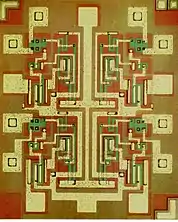2 nm process
In semiconductor manufacturing, the 2 nm process is the next die shrink after the 3 nm process node. As of 2020, both TSMC and Intel have 2nm products on their roadmaps, with earliest production scheduled for 2023 or later.
| Semiconductor device fabrication |
|---|
 |
|
(process nodes) |
Background
In late 2018, TSMC chairman Mark Liu predicted chip scaling would continue to 3 nm and 2 nm nodes;[1] however, as of 2019, other semiconductor specialists were undecided as to whether nodes beyond 3 nm could become viable.[2]
TSMC began research on 2 nm in 2019.[3] TSMC expected to transition from FinFET to GAAFET transistor types when moving from 3nm to 2nm.[4] It has been reported that TSMC is expected to enter 2 nm risk production around 2023 or 2024.[5]
Intel's 2019 roadmap scheduled potentially equivalent 3nm and 2nm nodes for 2025 and 2027 respectively.[6] In December 2019, Intel announced plans for 1.4 nm production in 2029.[7]
In August 2020, TSMC began building a R&D lab for 2nm technology in Hsinchu, expected to become partially operational by 2021.[8] In September 2020 (SEMICOM Taiwan 2020) it was reported that TSMC Chairman Mark Liu had stated the company would build a plant for the 2nm node at Hsinchu in Taiwan, and that it could also install production at Taichung dependent on demand.[9]
At the end of 2020, seventeen of the European Union countries signed a joint declaration to develop their entire semiconductor industry, including developing process nodes as small as 2 nm as well as a designing and manufacturing custom processors, assigning up to 145 billion Euro in funds.[10][11]
References
- Patterson, Alan (12 Sep 2018), "TSMC: Chip Scaling Could Accelerate", www.eetimes.com
- Merritt, Rick (4 March 2019), "SPIE Conference Predicts Bumpy Chip Roadmap", www.eetasia.com
- Zafar, Ramish (12 June 2019), TSMC To Commence 2nm Research In Hsinchu, Taiwan Claims Report
- "Highlights of the day: TSMC reportedly adopts GAA transistors for 2nm chips", www.digitimes.com, 21 Sep 2020
- "TSMC has achieved a breakthrough in 2nm, will adopt GAA technology and put it into production in 2023-2024", finance.technews.tw, 13 July 2020
- Cutress, Ian, "Intel's Manufacturing Roadmap from 2019 to 2029: Back Porting, 7nm, 5nm, 3nm, 2nm, and 1.4 nm", www.anandtech.com
- Cutress, Dr Ian. "Intel's Manufacturing Roadmap from 2019 to 2029: Back Porting, 7nm, 5nm, 3nm, 2nm, and 1.4 nm". www.anandtech.com.
- Wang, Lisa (26 Aug 2020), "TSMC developing 2nm tech at new R&D center", taipeitimes.com
- Chien-Chung, Chang; Huang, Frances (23 Sep 2020), "TSMC to build 2nm wafer plant in Hsinchu", focustaiwan.tw
- Dahad, Nitin (9 Dec 2020), "EU Signs €145bn Declaration to Develop Next Gen Processors and 2nm Technology", www.eetimes.eu
- Joint declaration on processors and semiconductor technologies, EU, 7 Dec 2020
Further reading
- Merritt, Rick (26 Mar 2018), "2nm: End of the Road ?", www.eetasia.com
| Preceded by 3 nm (FinFET) |
MOSFET semiconductor device fabrication process | Succeeded by ? |